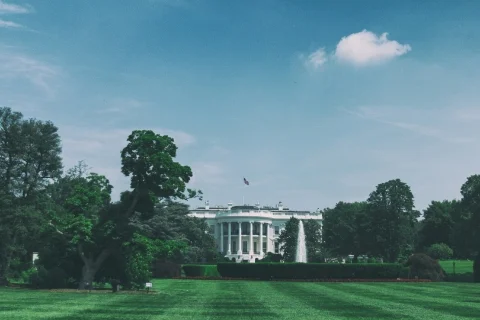An Investor’s Guide to the 2024 US Presidential Election
article • Investment Management

Prashant Tandon & Anusha Mazumder
2024-10-10 | 5 minutes
With Vice President Kamala Harris and former President Donald Trump running neck and neck in the Presidential campaign, investors may turn to economic and stock-market trends for insight into potential election outcomes. We have compiled data and key analyses about everything you need to know about the Presidential race.
The United States, with its colossal economy and unmatched military expenditure, holds a commanding position on the world stage, both economically and geopolitically. As the 2024 US Presidential Elections approach, the global ramifications of the election outcomes are significant, spanning short-term, medium-term, and long-term consequences not only for the Americas but also for Europe, Asia, Africa, and Australasia.
In this historic race, the two leading candidates present markedly different visions for the country's future. On one hand, former President Donald Trump’s potential return to the White House could signal a revival of his "America First" policies, with a focus on domestic economic growth and reducing international commitments and dependencies. On the other hand, Vice President Kamala Harris’s victory as the first female president in US history could lead to a shift in both domestic and foreign policy, moving the focus away from the current America-centric approach.
We delve into the key stages of the election, the importance of swing states, the possible outcomes for global markets, and the policy priorities of the Democratic and Republican parties. We also examine the evolution of the electorate, particularly the growing influence of the 18-29 age group, and analyse the potential threats to democratic institutions and the Federal Reserve's independence.
The Road to November 2024
The US election process is well underway. With the primaries and national conventions completed, both the Democratic and Republican parties have formally nominated their candidates. Election Day, scheduled for November 5, 2024, will be decided by the Electoral College, with 270 out of 538 electoral votes needed to secure the presidency. Traditionally, the winner is declared on election night, although, as seen in 2020, the counting process could extend for days. Once the votes are tallied, the newly elected president will be inaugurated on January 20, 2025.
In addition to the presidential election, voters will also cast ballots for all 435 seats in the House of Representatives and 34 seats in the Senate. These congressional elections are just as crucial since the balance of power in Congress will influence the next president’s ability to enact policy changes.
The Presidential Cycle and Market Performance
A concept widely referenced during US elections is Yale Hirsch’s four-year presidential cycle theory, which suggests that the stock market performance tends to follow a cyclical pattern based on the election cycle. Historically, the first year after an election tends to show slower growth as the new administration sets its agenda. Business leaders, investors, and consumers adopt a "wait-and-see" approach, resulting in market stagnation.
The second year, coinciding with midterm elections, often brings more uncertainty, further curbing market performance. However, the third year is typically the strongest for the market, as incumbents tend to push pro-business policies to bolster their chances for re-election. In contrast, the fourth year, being an election year, often brings increased market volatility due to the uncertainty surrounding the outcome. Historically, returns during the fourth year have been positive, but fluctuations are common, particularly in key swing states with unstable economic conditions.
Swing States: The Deciders
Swing states, often seen as the pivotal deciders in the election, are where the real battle for electoral votes takes place. These states hold 93 electoral votes, which could tip the balance in favour of either candidate.
In the industrial heartlands of Pennsylvania, Michigan, and Wisconsin, job losses and industrial decline are central issues. Policies that address manufacturing jobs will play a significant role in voter sentiment in these regions. Meanwhile, rapid urbanisation and demographic shifts have made Georgia and North Carolina hotly contested battlegrounds, where economic issues such as wages and unemployment will dominate voter concerns.
In states like Arizona and Nevada, immigration and trade policies are critical, especially given the growing immigrant populations. Economic policies tied to housing and job creation are likely to influence voters in these regions.
The Policy Divergence: Harris vs. Trump
Kamala Harris and Donald Trump present sharply contrasting policy priorities, which will shape the future of the US economy and its global relations. Harris’s proposals include increased taxes on the wealthiest individuals and corporations, with the intention of funding expanded social programs and healthcare access. She advocates for a stronger focus on labour rights, pushing for higher minimum wages and enhanced family leave policies. Harris is also a strong proponent of investing in renewable energy and climate resilience infrastructure, signalling a significant shift toward a green economy.
In contrast, Trump’s policies prioritise tax cuts and deregulation. His focus is on expanding the Tax Cuts and Jobs Act of 2017, reducing both corporate and individual taxes to stimulate private investment. Trump’s approach also includes rolling back regulations in the energy and financial sectors, with the aim of encouraging corporate growth. His tough stance on trade, particularly with China, is likely to continue, with tariffs being used as a key tool to bolster US manufacturing. Additionally, Trump’s platform includes a commitment to increasing defence spending, reinforcing the country's military strength.
The Evolving Electorate and Voter Turnout
Voter turnout in US elections has been steadily rising, with the 2020 election seeing a record 66.8% turnout, up from 61.4% in 2016. The turnout in the 2018 midterm elections also surged, reaching 50.3%, compared to 41.9% in 2014. Despite this upward trend, these figures highlight relatively low engagement for a country of such diverse demographics.
The youth vote, particularly those aged 18-29, has become increasingly important for both parties, with turnout in this demographic rising significantly in recent years. Race and ethnicity also play a growing role, with Hispanic and Asian-American voter participation on the rise, which is expected to influence future elections. Meanwhile, suburban voters, especially women, remain a key battleground, as their preferences could tip the balance in closely contested states.
Economic and Market Repercussions
In the short term, the election’s immediate aftermath could lead to sharp market reactions. Disputes over election results, especially if reminiscent of the contentious 2020 election, may spark market volatility. The potential for civil unrest and a contested election could exacerbate existing market sell-offs, particularly in the technology sector, which has seen stretched valuations in recent months.
It is important to maintain enough flexibility in the portfolio and not to over-commit to any consensus narrative, especially high-risk commitments.
In the medium term, the economic and policy directions under Harris and Trump will have significant global implications. Harris’s tax policies, particularly her focus on taxing the ultra-wealthy, could impact innovation and weaken the US's competitive edge globally. On the other hand, Trump’s proposed tariffs could increase prices for American consumers, with the brunt of the impact felt by lower- and middle-income households. These policies could lead to economic conflict and destabilise global markets.
Diversification is key. It is important to tactically adjust geographical weights, as monetary policy shifts can influence capital flows and relative growth rates between developed and emerging markets.
Over the long term, the global geopolitical landscape is shifting. Rising tensions with China, coupled with the unravelling post-World War II order, point to an uncertain future. Non-Western countries are moving toward de-dollarization and alternative financial structures, as seen in growing protectionism and nationalist policies. The outcome of the US elections will play a crucial role in shaping this evolving world order.
More than ever, from this decade's perspective, it is critical to review your asset allocation and risk management approach.
Final Thoughts
As the 2024 US Presidential Election approaches, the stakes are incredibly high, not only for the US but also for the world at large. The election will impact economic policies, market stability, and geopolitical alliances for years to come. While immediate market reactions may be sharp, the long-term risks and opportunities presented by this election require careful consideration from investors, business leaders, and global policymakers alike.
Vladimir Lenin’s famous words, “There are decades where nothing happens; and there are weeks where decades happen,” seem apt for the weeks leading up to the 2024 election. Decisions made during this period will likely shape the direction of the US—and the world—for decades to come.














